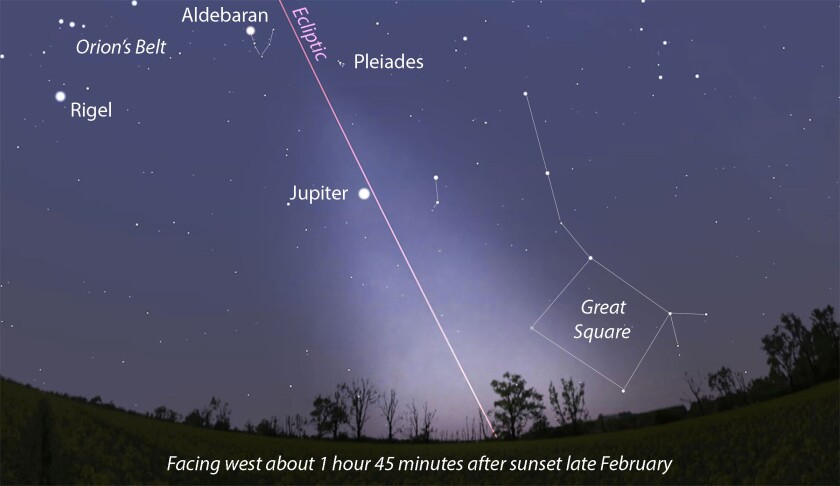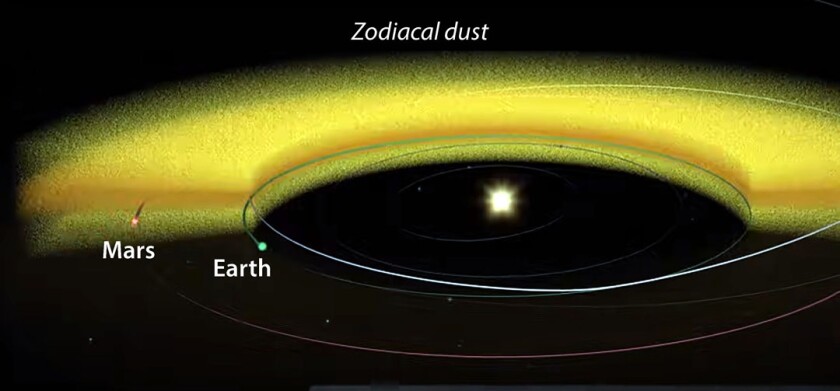One of the lesser known signs of winter transitioning to spring is the appearance of the zodiacal light at dusk. That's pronounced zoh-DIE-ah-cull and refers to the zodiac, a belt of sky about 8 degrees wide centered on the sun's apparent path across the sky. Along that path you'll find the 12 familiar zodiac constellations described in horoscopes — Leo, Virgo, Scorpius and so on. The sun spends roughly a month in each which adds up to a year.

Beginning in late winter, the angle at which the sun's path meets the western horizon tilts upward at a steep angle. In late fall and early winter, in contrast, it approaches sunset on a shallow, low-angled path. The steep tilt has a advantageous effect of lifting into view a pancake-shaped cloud of dust that lies in the plane of the solar system out to just beyond the orbit of Mars.

Each mote is about the same size as typical pollen grain and cast off by countless comets and colliding asteroids along with a significant contribution of dust from Mars . How material escapes the planet is still unknown. A much smaller fraction consists of interstellar dust snatched by the sun as it orbits about the center of the galaxy at more than 500,000 miles an hour (800,000 km/hour).
Even floaty dust particles add up — altogether the zodiacal dust cloud weighs some 20 trillion tons! Some of the material gets blown out of the solar system but most orbits the sun and gradually spirals inward until vaporized by its heat. Since the cloud has been with us a long, long time it must be continually replenished by its sources.
Dust is a good reflector and scatterer of sunlight. Picture yourself driving behind a truck on a dirt road in the direction of a low sun. The dust thrown up by the vehicle scatters sunlight so well it can be nearly impossible to see the road in front of you. Similarly, sunlight illuminates the zodiacal cloud and makes it glow with an unmistakable, soft radiance that resembles the Milky Way. And just like the Milky Way you'll need a dark sky — at least in the western direction — to see it. For all its massive girth the zodiacal light is a delicate thing and disappears in light-polluted skies. The moon must also be out of the picture.
ADVERTISEMENT
Since the dust lies in the plane of the solar system, which is defined by the ecliptic (the sun's apparent path), it straddles the zodiac, extending from Pisces, low in the west, through Aries and Taurus all the way to Gemini. The funnel-shaped glow starts out wide near the horizon and tapers and fades the higher it climbs. Jupiter gleams within its core with the Pleiades farther up.
The zodiacal light is best visible from 1 hour 45 minutes to 2 1/2 hours after sunset from Feb. 26 through March 11, a "dark window" when the moon is out of the sky. Find a spot in the country with a wide-open view to the west and allow at least 10 minutes for your eyes to dark-adapt.

You'll be looking for a huge, softly glowing wedge of light, brighter and broader nearer the horizon, narrowing as it towers upward beyond the Pleiades cluster. If you're having trouble distinguishing the gossamer glow, slowly turn your head to look to the left and right of west in order to better see how it contrasts with the dust-free sky. You should notice a dark gap separating the dust cone from the Milky Way, which arches over to the northwest in the direction of Cassiopeia. Photos of the phenomenon arouse our curiosity but don't do it justice. You simply must see it for yourself.
I'm always amazed that such minute particles can build something so big. But if you can do it with Legos why not dust?









